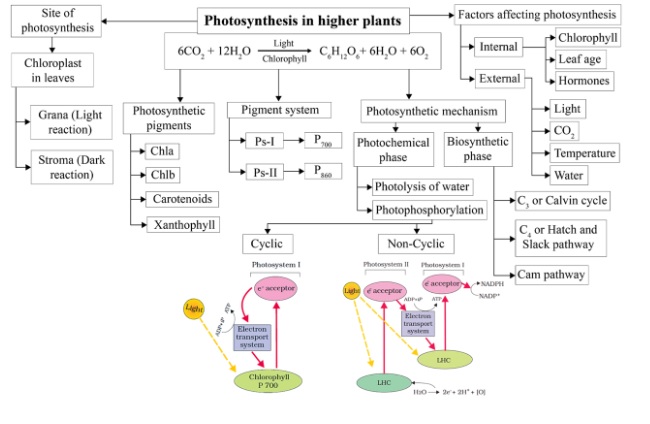NCERT Solutions for Class 11 Biology Chapter 11 - Photosynthesis in Higher Plants
FAQs on NCERT Solutions for Class 11 Biology Chapter 11 Photosynthesis In Higher Plants
1. Would it be Possible for Plants Containing a High Amount of Chlorophyll b to Carry Out Photosynthesis Even though they Lack Chlorophyll a? What is the Reason Behind Plants Containing Chlorophyll b and Other Essential Nutrients?
Ans: If the plants do not possess any amount of chlorophyll a, then it would be impossible for them to perform photosynthesis as chlorophyll-a acts as the prime pigment of the process. It is responsible for trapping light inside the leaf to carry out photosynthesis. Other essential pigments include chlorophyll b, carotenoids and xanthophylls which are responsible for absorbing sunlight and transferring energy to chlorophyll a. They also protect chlorophyll from photo-oxidation.
2. Observe the Leaves of a Plant Which are Under the Shade and Compare them with Leaves of the Same Plant Which are Under the Sunlight. Which of them are Dark Green, and Why?
Ans: As leaves kept under the shade absorb lesser sunlight, photosynthesis performed becomes less as well. To increase photosynthesis, trees under shades consist of more chlorophyll which in turn absorbs more sunlight and increases the photosynthesis. Thus, it makes the leaves under the shade have a greater shade of green as compared to those who are put under sunlight.
3. What are the benefits of NCERT Solutions for Class 11 Biology Chapter 11 Photosynthesis in higher plants?
Ans: The benefit of Class 11 Biology NCERT Solutions Chapter 11 Photosynthesis in higher plants is that the students get familiarity and understanding the concept of the chapter. The answers are very easy to understand. This chapter is from unit 11 of plant physiology. The NCERT solution helps the students to understand the complex chemicals and reactions which are responsible for conversion from light energy to chemical energy during the process of photosynthesis. The solutions are available on the Vedantu Mobile app and Vedantu website for free.
4. What are the Important Topics of NCERT Solutions for Class 11 Biology Chapter 11 Photosynthesis in higher plants?
Ans: The important topics in Class 11 Biology NCERT Solutions Chapter 11 are the composition of plant cells, metabolic process, how do the bacteria perform photosynthesis in the absence of chloroplasts, the relationship between photosynthesis and respiration, change in colour of the leaf, important products of light reaction, Calvin cycle, the difference between mitochondria and chloroplasts, photorespiration in C3 and C4 plants. Cyclic and non-cyclic photophosphorylation.
5. Why refer to Class 11 Biology NCERT Solutions Chapter 11?
Ans: Students should refer to the Class 11 Biology NCERT Solutions Chapter 11 to prepare for their exams. The Solutions provide answers to all the questions from the Class 11 Biology NCERT textbook in simple language. Hence, students can easily understand the concepts and learn the format of answers to be written in the exam.
6. What is photosynthesis in higher plants?
Ans: The energy required for the living organism to carry out the different activities comes from the sun. The green plants prepare their food from carbon dioxide and water in the presence of sunlight. The chemical energy is stored in the form of carbohydrates, starch and protein. Photosynthesis is a biochemical process wherein organic compounds are synthesised from inorganic compounds in the presence of sunlight. The product which is given out is oxygen.
7. Why is Photosynthesis important in Class 11?
Ans: Photosynthesis is very important for the survival and existence of life on earth. The plants prepare their food through the process of photosynthesis. While plants prepare their food through this process, they give out oxygen, which is essential for all organisms for survival. Thus, we can conclude that photosynthesis is very important.

























